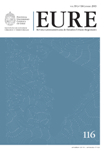The distance to market effect on rural poverty in the Metropolitan Region of Santiago
DOI:
https://doi.org/10.4067/S0250-71612013000100007Keywords:
spatial distribution, poverty, countryside-city relationshipAbstract
The national poverty headcount in Chile has declined considerably since 1990. In 2006, rural poverty rate fell below that of urban areas, due in part to population mobility. Rural areas, however, are still characterized by low educational levels and incomes, explained, in part, by low population density, remoteness to services, and limited access to markets for rural-produced products. This study finds that distance (measured as travel time) of rural populations to urban areas is associated with the incidence of poverty in rural communities after controlling for other factors. Using an econometric model based on geographical and socioeconomic information of the Metropolitan Region of Santiago, the study finds that poverty levels in census tracts increase with distance to Santiago, and, for a given distance, access to transportation reduces poverty, through a mitigation of the distance effect.
ÍDownloads
Published
How to Cite
Issue
Section
License
Copyright (c) 2013 Revista EURE - Revista de Estudios Urbano Regionales

This work is licensed under a Creative Commons Attribution 4.0 International License.
Al momento de aceptar la publicación de sus artículos, los autores deberán formalizar la cesión de derechos de autor a EURE, según las condiciones establecidas por la Revista.
Ésta establece que el autor autoriza a EURE de manera gratuita, exclusiva e ilimitada a reproducir, editar, publicar, distribuir, publicitar, comercializar y traducir el artículo, a cualquier soporte conocido o por conocer y desarrollar.
Del mismo modo, los autores aseguran que el artículo propuesto es original, no publicado y no propuesto para tal fin a otro medio de difusión.


